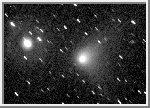|
COMETS EARTH JUPITER KUIPER BELT MARS MERCURY METEORITES NEPTUNE OORT CLOUD PLUTO SATURN SOLAR SYSTEM SPACE SUN URANUS VENUS ORDER PRINTS
PHOTO CATEGORIES SCIENCEVIEWS AMERICAN INDIAN AMPHIBIANS BIRDS BUGS FINE ART FOSSILS THE ISLANDS HISTORICAL PHOTOS MAMMALS OTHER PARKS PLANTS RELIGIOUS REPTILES SCIENCEVIEWS PRINTS
|
Related Document
Download Options
This is a CCD image of comet 1993a "Mueller", taken on October 6, 1993, using SBIG's ST-6 CCD-camera and a 288mm f/5.2 Schmidt-Cassegrain telescope.The exposure lasted from 19:11 U.T. to 19:21 U.T. The field of view is 19.6' x 14.4'. The comet has a coma diameter of some- what more than 3' and a fan-shaped tail, up to 7' long, between P.A. 220o and P.A. 310o. (Sorry, I mixed that up in my posting last week: 1993a has a fan-shaped tail oriented around P.A. 270o, while 1993p shows a slender AN-tail pointing nearly exactly northward. However, this an-tail may not be visible any longer...) The brightest star visible (PPM 7788) is of photographic magnitude 8.8. In this GIF-image, this star and the head of the comet appear to be nearly of the same brightness. However, a close inspection of the original CCD-image (which has a resolution of 16 bit per pixel rather than 8 bit for GIFs) shows that the star trail is satured at a value of 65535, while the brightest pixel in the comet's head reaches a value of only 15608. According to our measurements, the comet is of mag 10.5 in red light (where unfiltered, thick CCD's are most sensitive).Keep in mind that a comet has usually bright emissions in blue and green light, where our CCD is not that sensitive. (Courtesy Erich Meyer and Herbert Raab, Austria) |
